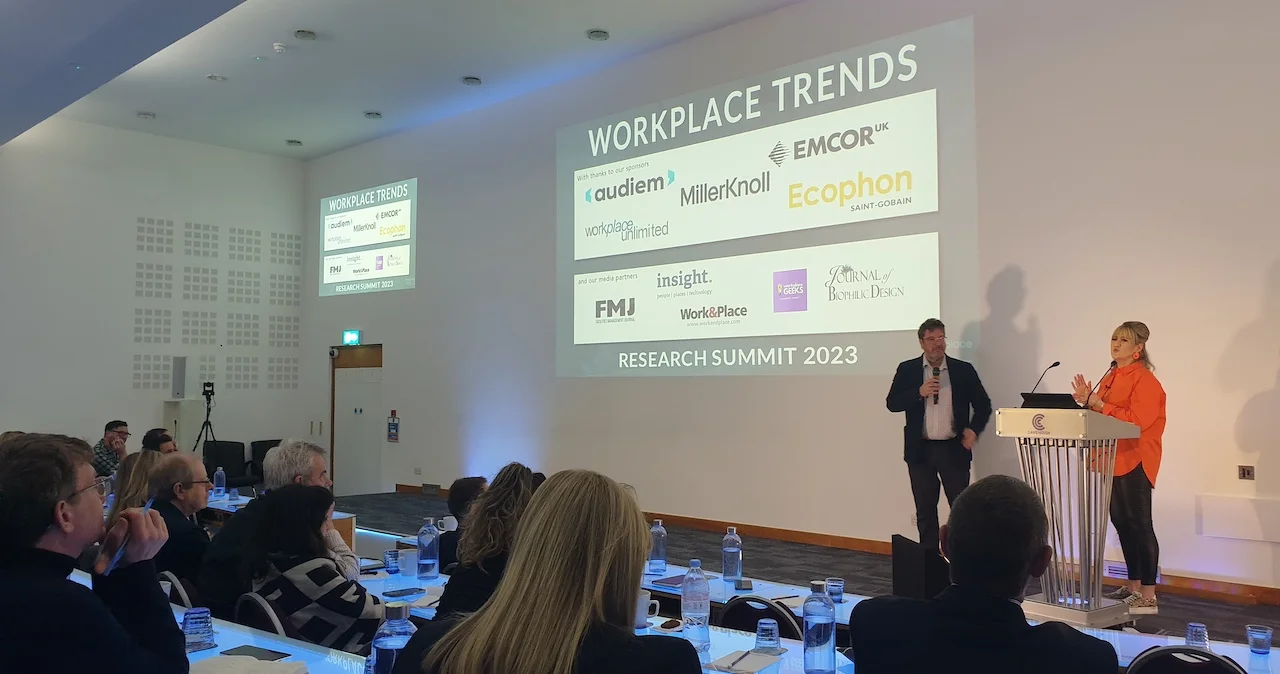Last week I attended the Workplace Trends Research Summit in London. As always, the event was packed full of data-led insight and fantastic speakers. I’ve picked out a few key takeaways from the day in my Workplace Trends recap.
Employee burnout
Employee wellbeing and hybrid working were, unsurprisingly, common threads between many of the presentations. Paige Hodsman presented findings from her pilot study at Brunel University that examined possible correlations between acoustic privacy and personality traits on burnout levels of UK office workers.
Acoustic factors can include the noise environment and type of noise. Five main personality types were considered, along with three indicators of burnout.
Paige found a number of correlational relationships and concluded that there is a “strong argument for considering both acoustics and personality traits on burnout and the associated costs to individuals, businesses, and society”.
As it is a pilot study there is more work to be done before we can draw firm conclusions, but it’s another reminder to FMs that noise is an important factor to consider in the workplace.
Alone together
Dr Harriet Shortt, associate professor in organisation studies and head of visual engagement at the University of the West of England, shared fascinating insight from a visual research study that asked what happens when you put a large group of people in a glass building.
The building in question was the Bristol Business School and Bristol Law School building, a £55m flagship space that opened in 2017. A 12-month study with 250 participants and more than 700 photos found that students and staff had a lot of issues with the space.
Students complained of feeling exposed in student support and presentation areas, while one staff member said “It is hard to overstate how those big glass walls have been detrimental to our capacity to work. You can’t do deep thinking if you fear being interrupted, and in those glass enclosures, you don’t just fear being interrupted, you know you will be”.
Dr Shortt found that people would make dens to customise their spaces. This involved taping paper onto glass walls to create privacy and draping clothes over booths.
Dr Shortt suggested that this points to a desire to be alone while around other people – both immersed and separate at the same time. As such, good workplace design should consider this evolving human need.
A sense of belonging
On a similar theme, Dr Dan Wakelin presented his findings from a study on engagement in the workplace. Dr Wakelin noted that one of the key assumptions of activity-based working is that people will switch between settings, and in fact choosing not to switch has often been seen as a transgression. However, he noted, thinly populated offices have reduced the need for switching behaviour and mobility.
Dr Wakelin also found that presence in the office created not only an increased sense of belonging, but even a loyalty scheme of sorts with special privileges. One participant in the research was informed that a team of administrators had claimed a spot – in an office with no reserved spaces – “because we’re here every day”.
This certainly raises questions for workplace managers about how to ensure an equitable office for all users, regardless of how often they use the space.
Put your people first
For all the talk of creating the optimum workplace, the team at Remit Consulting had a timely reminder for us all. They noted that a great workplace cannot compensate for mediocre teams and / or managers. In fact, the higher expectations that new employees have for a workplace, the greater sense of disappointment they can feel when placed in a mediocre team. So, creating great teams must be a priority for any workplace to be successful.
Industry insights from Magenta
We attend industry events throughout the year in the UK and abroad. Check out our blog for other event recaps and insights – and let us know which events you’ll be at so we can say hello!








